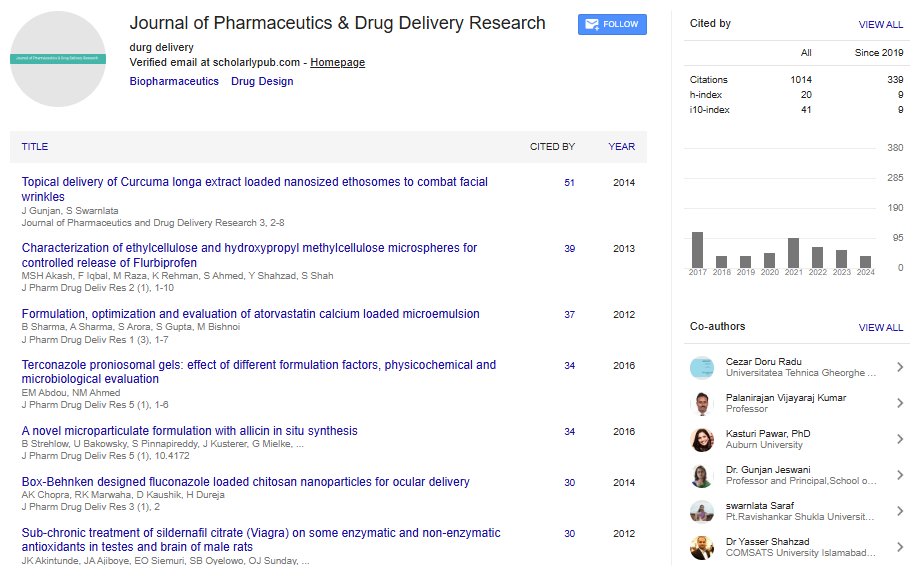Commentary, J Pharm Drug Deliv Res Vol: 13 Issue: 4
The Revolutionary Impact of Nanopharmaceutics on Modern Medicine
Sheila Vakharia*
1Department of Medicine, Aarhus University, Aarhus, Denmark
*Corresponding Author: Sheila Vakharia,
Department of Medicine, Aarhus
University, Aarhus, Denmark
E-mail: vakharias57@gmail.com
Received date: 01 July, 2024, Manuscript No. JPDDR-24-145759;
Editor assigned date: 03 July, 2024, PreQC No. JPDDR-24-145759 (PQ);
Reviewed date: 17 July, 2024, QC No. JPDDR-24-145759;
Revised date: 24 July, 2024, Manuscript No. JPDDR-24-145759 (R);
Published date: 31 July, 2024, DOI: 10.4172/2325-9604.1000288
Citation: Vakharia S (2024) The Revolutionary Impact of Nanopharmaceutics on Modern Medicine. J Pharm Drug Deliv Res 13:4.
Description
Nanopharmaceutics represents an innovative evolution in drug delivery and therapeutic strategies, merging the principles of nanotechnology with pharmacology to create more effective and targeted treatments. This interdisciplinary field holds the potential to revolutionize modern medicine by addressing some of the most significant challenges in drug development, such as poor solubility, limited bioavailability and undesirable side effects.
At the core of nanopharmaceutics lies the utilization of nanotechnology to design and develop pharmaceutical products at the nanoscale. These nanoscale drugs or drug delivery systems typically range in size from 1 to 100 nanometers, enabling them to interact with biological systems in novel ways that traditional drugs cannot. By manipulating materials at the molecular and atomic levels, researchers can create nanoparticles that enhance drug solubility, stability and bioavailability.
Many drugs with promising therapeutic effects suffer from poor solubility in water, which limits their bioavailability and efficacy. Nanopharmaceutics addresses this issue by utilizing nanoparticles to increase the solubility of hydrophobic drugs. For example, encapsulating a poorly soluble drug within a nanoparticle can significantly enhance its solubility, leading to improved absorption and bioavailability in the body.
One of the most significant advantages of nanopharmaceutics is the ability to target drugs to specific tissues or cells. Traditional drug delivery methods often result in systemic distribution, causing side effects and reducing the concentration of the drug at the target site. Nanoparticles can be engineered to deliver drugs directly to the site of action, such as a tumor, thereby increasing therapeutic efficacy while minimizing side effects. This targeted approach is particularly valuable in cancer treatment, where precision is essential for avoiding damage to healthy cells.
Nanopharmaceuticals can be designed to release their payloads in a controlled manner over time. This sustained release mechanism ensures a consistent therapeutic effect, reducing the need for frequent dosing and improving patient compliance. Controlled release systems can also protect the drug from premature degradation, ensuring that it reaches the target site in its active form.
By targeting drugs more precisely and reducing systemic exposure, nanopharmaceutics can significantly decrease the incidence of side effects. This is especially important for drugs with narrow therapeutic windows, where the margin between an effective dose and a toxic dose is small. Nanoparticles can help maintain drug concentrations within this therapeutic range, improving safety and efficacy.
Nanopharmaceutics has made significant strides in oncology, where nanoparticle-based drug delivery systems have been developed to improve the effectiveness of chemotherapy. For example, liposomal formulations of chemotherapeutic agents like doxorubicin have shown reduced toxicity and enhanced tumor targeting.
The development of nanoparticle-based vaccines has gained attention in recent years, particularly with the success of mRNA vaccines against COVID-19. These vaccines utilize lipid nanoparticles to deliver mRNA into cells, where it triggers an immune response. This approach has opened new avenues for the development of vaccines against various infectious diseases.
Nanopharmaceuticals are being explored for the treatment of neurodegenerative diseases like Alzheimer's and Parkinson's. Nanoparticles can cross the blood-brain barrier, a significant challenge in delivering drugs to the brain, allowing for more effective treatment of these conditions.
In cardiovascular medicine, nanopharmaceutics is being used to develop targeted therapies for conditions such as atherosclerosis and myocardial infarction. Nanoparticles can deliver drugs directly to atherosclerotic plaques or damaged heart tissue, promoting healing and reducing the risk of complications.
Despite its promise, nanopharmaceutics faces several challenges that must be addressed to fully realize its potential. These include issues related to the scalability of nanoparticle production, regulatory approval and long-term safety. Additionally, there is a need for more extensive clinical trials to validate the efficacy and safety of nanopharmaceutical products.
Looking forward, the future of nanopharmaceutics is bright, with ongoing research focused on developing even more sophisticated nanoparticle systems. Advances in nanomaterials, drug conjugation techniques and imaging technologies are expected to drive the next generation of nanopharmaceuticals, offering hope for more effective and personalized treatments for a wide range of diseases.
 Spanish
Spanish  Chinese
Chinese  Russian
Russian  German
German  French
French  Japanese
Japanese  Portuguese
Portuguese  Hindi
Hindi 
